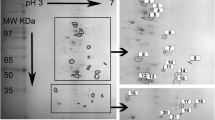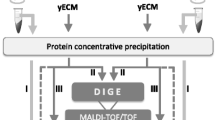Abstract
Bacteria undergo significant changes during adherence to surfaces and biofilm development. Cell-to-cell signalling molecules are known to be involved in these phenotypic adaptations to the sessile mode of life. We demonstrated previously that indole can act as an extracellular signal to regulate biofilm formation in E. coli. To identify proteins over- or under-expressed in response to E. coli biofilm formation and indole signalling, we compared the proteomes of the E. coli S17-1 wild-type and 3714 (S17-1 tnaA::Tn5) tryptophanase-negative mutant cells (which don’t produce indole) grown as suspensions or biofilms in the presence or absence of exogenous indole. From computer-assisted image analysis, 407 spots were discriminated on two-dimensional electropherograms. Principal component analysis (PCA) of the electropherograms did not discriminate between the proteomes of the wild-type and mutant cells grown as suspensions indicating that indole has a␣limited impact onto protein expression of planktonic cells. The first principal component extracted by PCA, after standardization of the observations, opposed planktonic and biofilm cells confirming the existence of changes in protein expression during E. coli biofilm formation. Among proteins over- or under-expressed by both sessile wild-type and mutant cells, we identified metabolic enzymes, transporters, proteins involved in the translation and transcription machinery, stress response and regulation, and signalling proteins. The wild-type and mutant strains grown as biofilms in the presence of indole were discriminated by the second component. The role of some proteins whose expression was altered in biofilm bacteria compared to suspended counterparts is discussed.
Similar content being viewed by others
References
Anyanful A, Dolan-Livengood JM, Lewis T, Sheth S, DeZalla MN, Sherman MA, Kalman LV, Benlan GM, Kalman D (2005) Paralysis and killing of Caenorhabditis elegans by enteropathogenic Escherichia coli requires the bacterial tryptophanase gene. Mol Microbiol 57:988–1007
Arevalo-Ferro C, Reil G, Gorg A, Eberl L, Riedel K (2005) Biofilm formation of Pseudomonas putida IsoF: the role of quorum sensing as assessed by proteomics. Syst Appl Microbiol 28:87–114
Barrios AF, Zuo R, Ren D, Wood TK (2006) Hha, YbaJ and OmpA regulate Escherichia coli K12 biofilm formation and conjugation plasmids abolish motility. Biotechnol Bioeng 93(1):188–200
Beloin C, Valle J, Latour-Lambert P, Faure P, Kzreminski M, Balestrino D, Haagenses JAJ, Molin S, Prensier G, Arbeille B, Ghigo JM (2004) Global impact of mature biofilm lifestyle on Escherichia coli K-12 gene expression. Mol Microbiol 51:659–674
Blattner FR, Plunkett G 3rd, Bloch CA, Perna NT, Burland V, Riley M, Collado-Vides J, Glasner JD, Rode CK, Mayhew GF, Gregor J, Davis NW, Kirkpatrick HA, Goeden MA, Rose DJ, Mau B, Shao Y (1997) The complete genome sequence of Escherichia coli K-12. Science 5:1453–1474
Blazer GJ, McLean RJ (2002) The stringent response genes relA and spoT are important for Escherichia coli biofilms under slow-growth conditions. Can J Microbiol 48:675–680
Branny P, Pearson JP, Pesci EC, Köhler T, Iglewski BH, Van Delden C (2001) Inhibition of quorum sensing by a Pseudomonas aeruginosa dksA homologue. J Bacteriol 183: 1531–1539
Brown L, Gentry D, Elliot T, Cashel M (2002) DksA affects ppGpp induction of RpoS at a translational level. J Bacteriol 184:4455–4465
Di Martino P, Merieau A, Phillips R, Orange N, Hulen C (2002) Isolation of an Escherichia coli strain mutant unable to form biofilm on polystyrene and to adhere to human pneumocyte cells: involvement of tryptophanase. Can J Microbiol 48:132–137
Di Martino P, Fursy R, Bret L Sundararaju B, Phillips RS (2003) Indole can act as an Extracellular Signal to Regulate Biofilm Formation in Escherichia coli and in other Indole-producing Bacteria. Can J Microbiol 43:443–449
Dykes GA, Sampathkumar B, Korber DR (2003) Planktonic or biofilm growth affects survival, hydrophobicity and protein expression patterns of a planktonic Campylobacter jejuni strain. Int J Food Microbiol 89:1–10
Ghigo JM (2001) Natural conjugative plasmids induce bacterial biofilm development. Nature 412:442–445
Gonzales Barrios AFG, Zuo R, Hashimoto Y, Yang L, Bentley WE, Wood TK (2006) Autoinducer 2 controls biofilm formation in Escherichia coli through a novel motility quorum-sensing regulator (MqsR, B3022). J Bacteriol 188:305–316
Gurevich AI, Avakov AE, Kolosov MN (1979) The nucleotide sequence at the proximal end of rpoB gene of Escherichia coli. Bioorg Khim 5:1735–1739
Hirakawa H, Inazumi Y, Masaki T, Hirata T, Yamaguchi A (2005) Indole induces the expression of multidrug exporter genes in Escherichia coli. Mol Microbiol 55:1113–1126
Joloba ML, Rather PN (2003) Mutations in deoB and deoC alter an extracellular signalling pathway required for activation of the gab operon in Escherichia coli. FEMS Microbiol Lett 228:151–157
Jubete Y, Zabala JC, Juarez A, de la Cruz F (1995) hlyM, a transcriptional silencer downstream of the promoter in the hly operon of Escherichia coli. J Bacteriol 177:242–246
Lacour S, Landini P (2004) σS-dependent gene expression at the onset of stationary phase in Escherichia coli: function of σS-dependent genes and identification of their promoter sequences. J Bacteriol 186:7186–7195
Landini P, Zehnder AJB (2002) The global regulatory hns gene negatively affects adhesion to solid surfaces by anaerobically grown Escherichia coli by modulating expression of flagellar genes and lipopolysaccharide production. J Bacteriol 184:1522–1529
Nieto JM, Madrid C, Prenafeta A, Miquelay E, Balsalobre C, Carrascal M, Juarez A (2000) Expression of the hemolysin operon in Escherichia coli is modulated by a nucleotid-protein complex that includes the proteins Hha and H-NS. Mol Gen Genet 263: 349–358
Nyström T, Neidhardt FC (1994) Expression and role of the universal stress protein, UspA, of Escherichia coli during growth arrest. Mol Microbiol 11:537–544
Olson ER, Dunyak DS, Jurss LM, Poorman RA (1991) Identification and characterization of dppA, an Escherichia coli gene encoding a periplasmic dipeptide transport protein. J Bacteriol 173:234–244
Oosthuizen MC, Steyn B, Lindsay D, Brözel VS, von Holy A (2001) Novel method fort he proteomic investigation of a dairy-associated Bacillus cereus biofilm. FEMS Microbiol Methods 194:47–51
Oosthuizen MC, Steyn B, Theron J, Cosette P, Lindsay D, von Holy A, Brözel VS (2002) Proteomic analysis reveals differential protein expression by Bacillus cereus during biofilm formation. Appl Environ Microbiol 68:2770–2780
O’Toole R, Williams HD (2003) Universal stress proteins and Mycobacterium tuberculosis. Res Microbiol 154:387–392
Park SJ, Cotter PA, Gunsalus RP (1995) Regulation of malate dehydrogenase (mdh) gene expression in Escherichia coli in response to oxygen, carbon, and heme availability. J Bacteriol 177:6652–6656
Perederina A, Svetlov V, Vassylyeva MN, Tahirov TH, Yokoyama S, Artsimovitch I, Vassylyev DG (2004) Regulation through the secondary channel-structural framework for ppGpp-DksA synergism during transcription. Cell 1183:297–309
Perrot F, Hebraud M, Charlionet R, Junter GA, Jouenne T (2000) Protein pattern of gel-entrapped Escherichia coli cells differ from those of free-floating organisms. Electrophoresis 21:645–653
Perrot F, Hebraud M, Charlionet R, Junter GA, Jouenne T (2001) Cell immobilization induces changes in the protein response of Escherichia coli K-12 to a cold shock. Electrophoresis 22:2110–2119
Prigent-Combaret C, Vidal O, Dorel C, Lejeune P (1999) Abiotic surface sensing and biofilm-dependent regulation of gene expression in Escherichia coli. J Bacteriol 181:5993–6002
Rabilloud T (1999) Silver staining of 2-D electrophoresis gels. Methods Mol Biol 112:297–305
Reisner A, Haagensen JA, Schembri MA, Zechner EL, Molin S (2003) Development and maturation of Escherichia coli K-12 biofilms. Mol Microbiol 48:933–946
Ren D, Bedzyk LA, Thomas SM, Ye RW, Wood TK (2004) Gene expression in Escherichia coli biofilms. Appl Microbiol Biotechnol 64:515–524
Sauer K (2003) The genomics and proteomics of biofilm formation. Genome Biol 4:219
Sauer K, Camper AK (2001) Characterization of phenotypic changes in Pseudomonas putida in response to surface-associated growth. J Bacteriol 183:6579–6589
Sauer K, Camper AK, Ehrlich G DJW, Davies DG (2002) Pseudomonas aeruginosa displays multiple phenotypes during development as a biofilm. J Bacteriol 184:1140–1154
Schembri MA, Kjaergaard, Klemm P (2003) Global gene expression in Escherichia coli biofilms. Mol Microbiol 48:253–267
Schreiber K, Boes N, Eschbach M, Jaensch L, Wehland J, Bjarnsholt T, Givskov M, Hentzer M, Schobert M (2006) Anaerobic survival of Pseudomonas aeruginosa by pyruvate fermentation requires an Usp-type stress protein. J Bacteriol 188:659–668
Seefeld MA, Miller WH, Newlander KA, Burgess WJ, Payne DJ, Rittenhouse SF, Moore TD, De Wolf Jr. WE, Keller PM, Qiu X, Janson CA, Vaidya K, Fosberry AP, Smyth MG, Jaworski DD, Slater-Radosti C, Huffman WF (2001) Inhibitors of bacterial enoyl acyl carrier protein reductase (FabI): 2,9-disubstituted 1,2,3,4-tetrahydropyrido[3,4-b]indoles as potential antibacterial agents. Bioorg Med Chem Letters 11:2241–2244
Simon R, Priefer U, Pehle A (1983) A broad host range mobilization system for in vitro genetic engineering: transposon mutagenesis in gram negative bacteria. Biotechnology 1:784–890
Steyn B, Oosthuizen MC, MacDonald R, Theron J, Brozel VS (2001) The use of glass wool as an attachment surface for studying phenotypic changes in Pseudomonas aeruginosa biofilms by two-dimensional gel electrophoresis. Proteomics 1:871–879
Svensäter G, Welin J, Wilkins JC, Beighton D, Hamilton IR (2001) Protein expression by planktonic and biofilm cells of Streptococcus mutans. FEMS Microbiol Lett 205:139–146
Tomlin KL, Malott RJ, Ramage G, Storey DG, Sokol PA, Ceri H (2005) Quorum-sensing mutations affect attachment and stability of Burkholderia cenocepacia biofilms. Appl Environ Microbiol 71:5208–5218
Trémoulet F, Duché O, Namane A, Martinie B, The European Listeria Genome Consortium, Labadie JC (2002a) Comparison of protein patterns of Listeria monocytogenes grown in biofilm or in planktonic mode by proteomic analysis. FEMS Microbiol Lett 210:25–31
Trémoulet F, Duché O, Namane A, Martinie B, Labadie JC (2002b) A proteomic study of Escherichia coli O157:H7 NCTC 12900 cultivated in biofilm or in planktonic growth mode. FEMS Microbiol Lett 215:7–14
Vilain S, Cosette P, Hubert M, Lange C, Junter GA, Jouenne T (2004a) Proteomic analysis of agar-entrapped Pseudomonas aeruginosa. Proteomics 4:1996–2004
Vilain S, Cosette P, Hubert M, Lange C, Junter GA, Jouenne T (2004b) Comparative proteomic analysis of planktonic and immobilized Pseudomonas aeruginosa cells: a multivariate statistical approach. Anal Biochem 329:120–130
Vilain S, Cosette P, Zimmerlin I, Dupont J-P, Junter G-A, Jouenne T (2004c) The biofilm proteome: homogeneity or versatility? J Prot Res 3:133–136
Wang D, Ding X, Rather PN (2001) Indole can act as an extracellular signal in Escherichia coli. J Bacteriol 183: 4210–4216
Yang W, Ni L, Somerville RL (1993) A stationary-phase protein of Escherichia coli that affects the mode of association between the trp repressor protein and operator-bearing DNA. Proc Natl Acad Sci U S A 90:5796–800
Author information
Authors and Affiliations
Corresponding author
Rights and permissions
About this article
Cite this article
Collet, A., Vilain, S., Cosette, P. et al. Protein expression in Escherichia coli S17-1 biofilms: impact of indole. Antonie van Leeuwenhoek 91, 71–85 (2007). https://doi.org/10.1007/s10482-006-9097-3
Received:
Accepted:
Published:
Issue Date:
DOI: https://doi.org/10.1007/s10482-006-9097-3




